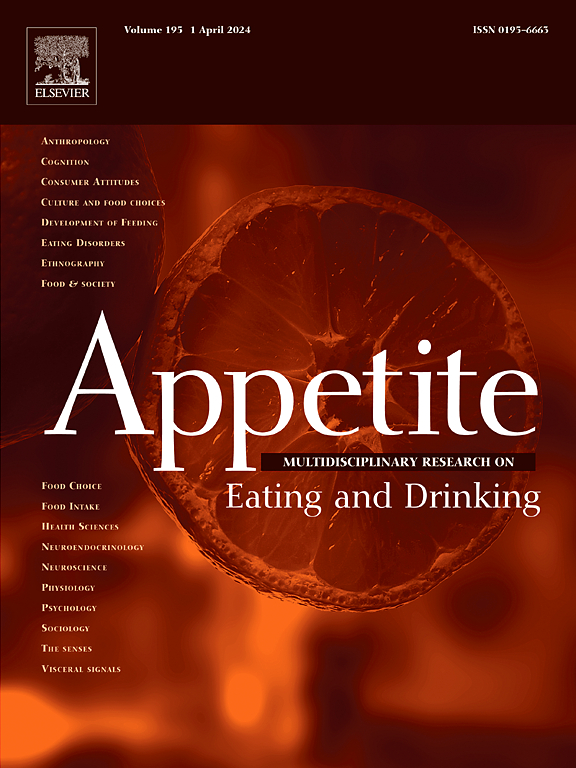Impact of ultra-processed foods on hedonic and homeostatic appetite regulation: A systematic review
IF 4.6
2区 医学
Q1 BEHAVIORAL SCIENCES
引用次数: 0
Abstract
The rapid rise in ultra-processed foods (UPF) consumption correlates with the growing global obesity prevalence. Investigating the hedonic and homeostatic mechanisms affected by UPF may provide insights for obesity prevention and appetite regulation. This systematic review aimed to examine the current understanding of the potential effects of UPF on appetite regulation and food intake, examining both hedonic and homeostatic pathways. A search was performed in PubMed, Scopus, Web of Science, and EMBASE databases, and studies published in English language were selected. Study selection and inclusion/exclusion criteria were determined based on PECOS framework. The quality of the studies was evaluated using appropriate Cochrane Risk of Bias tools and all articles were found to have low risk of bias. Of the 11 studies included, three were randomized controlled trials, one was cross-over study, one was non-randomized controlled study, and six were observational studies. Results indicated that UPF consumption may influence to hedonic appetite by promoting faster eating rates, enhancing palatability, activating brain reward circuits, and potentially increasing food addiction behaviors. Additionally, UPF intake may disrupt homeostatic appetite regulation by altering gut-brain axis signaling and modulating peripheral peptides such as ghrelin, GLP-1, GIP, and PYY. However, findings on both hedonic and homeostatic mechanisms remain inconclusive due to heterogeneous study designs, general characteristics of participants, and varying baseline UPF intake. These findings suggest that reducing UPF consumption could be a relevant target for appetite and weight management strategies, highlighting the need for more mechanistic and longitudinal research.
超加工食品对享乐和内稳态食欲调节的影响:系统综述。
超加工食品(UPF)消费的快速增长与全球肥胖患病率的上升有关。研究UPF影响的享乐和内稳态机制可能为肥胖预防和食欲调节提供见解。本系统综述旨在检查UPF对食欲调节和食物摄入的潜在影响的当前理解,检查享乐和稳态途径。检索PubMed、Scopus、Web of Science和EMBASE数据库,选择以英文发表的研究。根据PECOS框架确定研究选择和纳入/排除标准。使用适当的Cochrane偏倚风险工具评估研究的质量,所有文章均为低偏倚风险。纳入的11项研究中,3项为随机对照试验,1项为交叉研究,1项为非随机对照研究,6项为观察性研究。结果表明,UPF消费可能通过促进更快的进食速度、增强可口性、激活大脑奖励回路和潜在的增加食物成瘾行为来影响享乐性食欲。此外,UPF摄入可能通过改变肠-脑轴信号和调节外周肽(如胃饥饿素、GLP-1、GIP和PYY)来破坏稳态食欲调节。然而,由于异质研究设计、参与者的一般特征和不同的UPF基线摄入量,关于享乐和体内平衡机制的研究结果仍然没有定论。这些发现表明,减少UPF消耗可能是食欲和体重管理策略的相关目标,强调需要更多的机械和纵向研究。
本文章由计算机程序翻译,如有差异,请以英文原文为准。
求助全文
约1分钟内获得全文
求助全文
来源期刊

Appetite
医学-行为科学
CiteScore
9.10
自引率
11.10%
发文量
566
审稿时长
13.4 weeks
期刊介绍:
Appetite is an international research journal specializing in cultural, social, psychological, sensory and physiological influences on the selection and intake of foods and drinks. It covers normal and disordered eating and drinking and welcomes studies of both human and non-human animal behaviour toward food. Appetite publishes research reports, reviews and commentaries. Thematic special issues appear regularly. From time to time the journal carries abstracts from professional meetings. Submissions to Appetite are expected to be based primarily on observations directly related to the selection and intake of foods and drinks; papers that are primarily focused on topics such as nutrition or obesity will not be considered unless they specifically make a novel scientific contribution to the understanding of appetite in line with the journal's aims and scope.
 求助内容:
求助内容: 应助结果提醒方式:
应助结果提醒方式:


